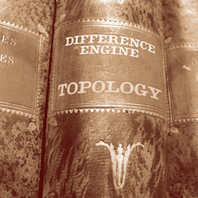www.topologymusic.com
 |
Topology, Difference Engine |
Topology members must the happiest people—this is fun music that lifts your spirits. But it’s music with real depth. Difference Engine is a CD for entertainment and contemplation. Though newly released, the works in this compilation date from 1997–2003 and presumably the ensemble has thoroughly road-tested them—the superb playing evinces the musicians’ total familiarity with and immersion in the material.
All but one of the four works was written by ensemble members, the other being by Lynette Lancini, whose four-movement Centaur (2000) opens the disc. Three of the movements are named after gemstones and one after a flower, and the titles are intended to reflect their character. Obsidian opens with a rapid motoric theme that dramatically slows before returning to a stabbing pace. Jasper starts dreamily, with a steady piano ostinato threading through, blending lovely violin, viola, bowed bass, piano and sax lines that build in earnestness. The brief but evocative Heliotrope (the purple flower of mourning) begins with suitably mournful strings and sax over a steady bass, jumps to an up-tempo, angular fugue-like passage and then just as abruptly slows again, concluding with a soulful piano finale. Sapphire, the longest and most involving movement, opens with a jaunty folk-like riff on strings threaded with sweet soprano sax. Slowing to a gentle stroll, it develops increasing textural complexity and builds to an evocative crescendo. This 23-minute suite traverses much compositional and emotional territory —great writing that bears repeated listening.
Saxophonist John Babbage’s 2003 work φX174 (named, we are told, after the first-ever completely mapped genome of any organism) starts with offbeat, rhythmic strings and piano from which a lovely slow violin line develops, shifts to a rapid motoric form and then returns to a gentle stepping pace. The CD liner notes suggest the musical material is a representation of the DNA code, but it sounds fresh and energetic rather than overly calculated.
Bassist Robert Davidson’s 1997 Exterior (in two movements) is an excerpt from his much longer Four Places, and the ensemble includes Ron Colbers guesting on djembe, adding a very different feel to the music. The driving offbeat opening is followed by a mellifluous sax solo that segues into a hypnotic viola solo supported by bowed bass before returning to the opening theme. The work alternates forceful, rhythmic movement with wistful introspection as it unfolds. My favourite on this CD, Exterior evidently involves much improvisation, but feels carefully structured. Bernard Hoey is superb on viola.
The final work, Babbage’s 2001 Difference Engine, is in three movements: the first is arrhythmic and dissonant, the second begins brightly then slows, and the short third movement opens slowly and quizzically and concludes with a few brief piano figures that hauntingly die away under the pedal. The title refers to the calculating machine designed two centuries ago by the (unrelated) mathematician Charles Babbage—another musical metaphor for a scientific milestone, though you wouldn’t guess it without the liner notes. The work sounds expressionistic and is evidently based on the space between notes as measured in distance rather than time, yielding a series of “differences.'
These compositions sound as if they have grown out of experiments that have resolved themselves into a style. If this music had its roots in minimalism, it has evolved into something far more complex—a repetitive motif might be overlayed with a long, seductive melody; there are sudden shifts in tempo and dynamics, leading instruments swap roles, and there are multiple competing lines and tempi. Conlon Nancarrow and Frank Zappa leap to mind. The power in these compositions lies in their interweaving, polyphonic lines that create enchanting textures, and their bouncy energy. The style shifts though jazz syncopations, rock and other forms, and the mood alternates forceful statement with gentle crooning. Any mathematical dryness is offset by the rich tone colour and developmental peaks that tease the attention. Free of gimmicks, this music is lush, infectious, upbeat and accessible, yielding tunes that pop into your mind all day, but it’s also seriously demanding and rewarding, a difficult balance but well achieved. There is scope for solo virtuosity, but mostly this music requires and enables brilliant ensemble playing, which Topology delivers effortlessly.
This long-established five-piece has made its name through finding new musical territory that draws many flavours into a unique mix. Given their previous forays into everything from classical chamber works to pop, comedy and funk, Difference Engine seems very straight but it’s a superbly crafted and very satisfying CD.
Chris Reid
© Chris Reid; for permission to reproduce apply to [email protected]








 back
back